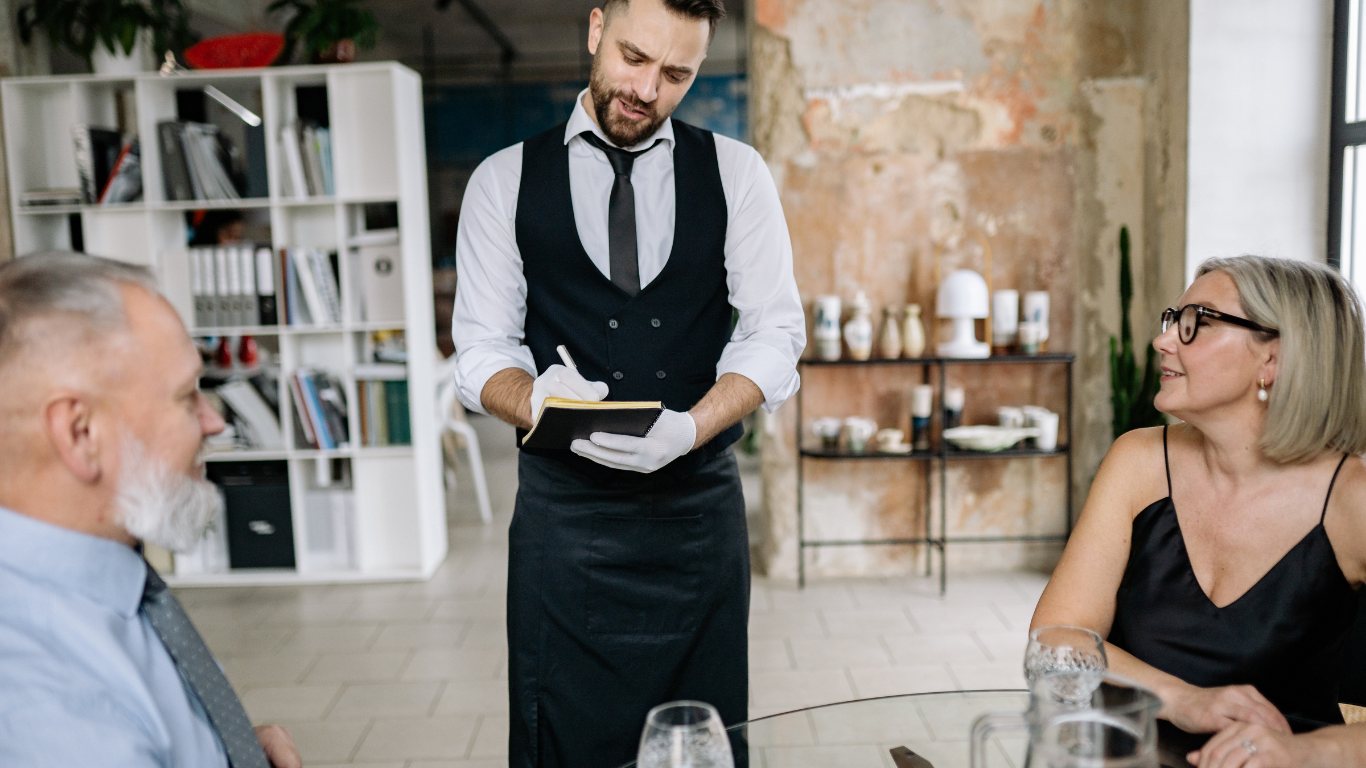
Requesting Recommendations from the Waiter
Learn how to ask a waiter for recommendations at a restaurant. Our beginner-friendly dialogues help you discover new dishes and feel more confident when you're not sure what to order.
BEGINNER
Vocabulary
recommend
To say that something is good and suggest that someone should try it.
- What do you recommend from the menu?
- The waiter recommended the fish.
- I can recommend this restaurant to my friends.
spicy
Having a strong taste of spices that can feel hot in the mouth.
- I like spicy food.
- Is this dish very spicy?
- I prefer food that is not too spicy.
Grammar Tip: Using 'do you' for questions
To ask about someone's opinion or preference, you can start with 'What do you...?' or 'Do you...?' For example, 'What do you recommend?' and 'Do you have a favorite?' are simple, useful questions.
Common Mistakes
❌ Saying 'What is good here?' instead of 'What do you recommend?'
✅ While 'What is good here?' is understandable, 'What do you recommend?' is more polite and natural.
Asking 'what do you recommend' shows that you value the waiter's opinion and knowledge of the menu. It's a key phrase for dining out.
❌ Using 'hot' for spicy food.
✅ When talking about the taste of a dish, use 'spicy.' 'Hot' is used for temperature.
This is a common mistake for English learners. A 'hot' dish can be physically hot (high temperature) or spicy. Using 'spicy' removes any confusion.
Notes for Learners
- Use 'Hello' or 'Excuse me' to get the waiter's attention first.
- Be ready with follow-up questions about the dish, like 'Is it spicy?' or 'What is in it?'
- Say 'Thank you' after you receive the recommendation.
- Practice confirming your order by saying 'That's right' or 'Okay, I'll have that.'
INTERMEDIATE
Vocabulary
popular
Liked by many people.
- This is a very popular restaurant in the city.
- The tacos are one of our most popular dishes.
- The park is a popular place for families to visit.
serve
To provide food or drinks to someone.
- The food is served hot.
- We serve breakfast from 7 a.m. to 10 a.m.
- The waiter served our main course.
Grammar Tip: Asking about personal opinions
To ask for a personal opinion, use phrases like 'Do you have a favorite...?' or 'What do you personally recommend?' This shows you are interested in their individual suggestion, not just a general one.
Common Mistakes
❌ Asking for 'good food' instead of 'popular dishes' or 'personal favorites.'
✅ Be more specific with your question. Ask about 'popular dishes' or the waiter's 'personal favorites.'
These phrases help the waiter give you a more specific and helpful answer. They know what people like or what they personally enjoy, which is more useful than a general question.
❌ Not using a full question when asking what the dish comes with.
✅ Use a full question like 'What does it come with?' instead of just 'What with?'
Using a complete sentence is a sign of good grammar and helps with clarity. It's a simple change that makes you sound much more natural.
Notes for Learners
- When you're not sure, it's a good idea to explain why you are asking for a recommendation (e.g., 'I'm not sure what to order').
- Be ready to ask follow-up questions about the recommended dish, like what it's served with.
- Notice how the waiter uses words like 'popular' and 'highly recommend.'
- Say 'I think I'll go with...' to make your final choice.
ADVANCED
Vocabulary
exquisite
Extremely beautiful or delicious.
- The food at that restaurant was exquisite.
- She wore an exquisite necklace to the party.
- The chef prepared an exquisite meal.
rave reviews
Enthusiastic and very positive comments or praise.
- The new movie is getting rave reviews.
- The dessert received rave reviews from all the customers.
- The restaurant is famous for its rave reviews.
Grammar Tip: Using 'be able to' for polite requests
Using 'be able to' in phrases like 'Would you be able to...?' is a very polite and formal way to ask a question. It's often used when you are asking someone to do something for you, and it shows great respect.
Common Mistakes
❌ Using simple words like 'good' or 'nice' when describing a dish.
✅ Use more descriptive and sophisticated words like 'exquisite' or 'delicious' to show a higher level of vocabulary.
Advanced learners should use a richer vocabulary to express themselves. Words like 'exquisite' and 'delicious' are more common in fine dining settings and show a greater command of English.
❌ Not offering context for your request.
✅ Start with a phrase like 'We are having a difficult time deciding...' to give the waiter a reason for your request.
Adding context makes the conversation more natural and humanized. It shows that you are not just asking a question, but are starting a dialogue.
Notes for Learners
- Be ready to ask for recommendations for a specific part of the menu, like 'the chef's specials.'
- Use phrases like 'I appreciate your input' to show thanks and respect for the waiter's suggestions.
- Listen for advanced vocabulary and phrases from the waiter, like 'rave reviews' or 'nothing but rave reviews.'
- The best way to show you are an advanced speaker is by using a range of vocabulary and polite phrases that are appropriate for the setting.